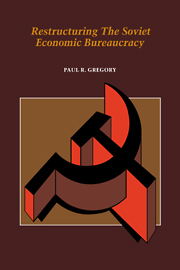Preface
Published online by Cambridge University Press: 24 March 2010
Summary
Conventional wisdom both inside and outside the Soviet Union is that the bureaucracy represents the greatest threat to Gorbachev's perestroika (restructuring). This fear has aroused Soviet interest in how the economic bureaucracy works. In fact, the cumbersome and bloated bureaucracy has been singled out as a chief source of economic stagnation. The bureaucracy's press has been uniformly bad, and the bureaucracy's malpractices have been gleefully exposed by an unleashed Soviet press.
This book examines the way the Soviet economic bureaucracy has worked over the years. As of mid-1989, the bureaucracy continued to operate in much the same way that it had since the 1930s. Numerous complaints from enterprise officials and ministry personnel in the Soviet press confirm this point. In effect, this book is about the bureaucratic practices that perestroika seeks to change. Understanding how the bureaucratic system works sheds light on why the system has been so difficult to change and on the bureaucratic resistance that perestroika will face. In fact, the risk that the findings of this book will be outmoded by the successes of restructuring is small. Previous efforts to change bureaucratic practices have failed; at best, significant changes will be achieved slowly.
The research reported in this book is based on Soviet and Western published accounts and on interviews with former members of the Soviet economic bureaucracy who emigrated to the West. The published and interview sources complement each other.
- Type
- Chapter
- Information
- Restructuring the Soviet Economic Bureaucracy , pp. xi - xiiPublisher: Cambridge University PressPrint publication year: 1990

